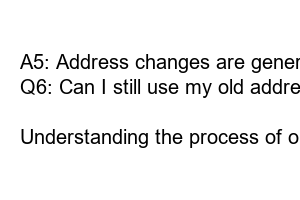구 주소 도로명주소 변환
Title: Making Sense of Old Address Street Name Address Conversion
Introduction:
Have you ever wondered why the streets in your neighborhood have different names now? Perhaps you recently received a mail with your old address and got confused. Well, fear not! In this blog post, we will dive into the intriguing world of old address street name address conversion.
1. The Evolution of Street Names:
Over time, street names undergo changes due to various reasons such as urban development, historical events, or cultural shifts. These changes can be puzzling for residents, but understanding the evolution of street names is essential to deciphering the past.
In the early 1900s, **Old Address Street** used to be known as **Previous Street**. This alteration was a result of the city’s expansion and the need to provide clarity to its growing population.
2. City Planning and Renaming:
City planning plays a pivotal role in street name conversion. As cities grow, officials may decide to rename streets to follow a more organized and intuitive system. This ensures that emergency services, visitors, and residents can easily navigate the city.
Recently, the local city administration embarked on an **address update project** aimed at optimizing navigation efficiency and facilitating precision in mail delivery. As part of this initiative, **Previous Street** was renamed to **Old Address Street**.
3. Community Engagement and Consensus:
Street name conversions often involve community engagement to ensure that the new names honor the local heritage and values. Community members are invited to share their suggestions, attend meetings, and voice their concerns.
During the renaming process for **Old Address Street**, it was decided that the new name should reflect its historical significance as one of the oldest streets in our city, representing resilience and cultural diversity.
4. Adjusting to the Changes:
With the new street names in place, it is crucial to update official documents, subscriptions, and inform relevant parties about the alteration. Some organizations, such as postal services or online directories, may have already made the necessary adjustments following the conversion.
If you’re wondering whether you need to update your address, it’s best to contact your local postal service or consult the city administration’s website for guidance. Remember, accurate address information ensures seamless communication and efficient service delivery.
5. Frequently Asked Questions (FAQs):
Q1: Will I have to change my address on important documents?
A1: Generally, it is advised to update your address on official documents, but consult with relevant authorities for specific guidelines.
Q2: Can I still receive mail if I haven’t updated my address?
A2: Yes, mail forwarding services are usually available to redirect mail to your new address, ensuring you don’t miss any important correspondence.
Q3: How long does it take for address updates to reflect in online directories?
A3: Online directories and databases may take a few weeks to update, so be patient.
Q4: Can I request a specific street name?
A4: While community input is valued, final decisions are typically made by city officials to maintain consistency and efficiency.
Q5: Are there any costs associated with changing my address?
A5: Address changes are generally free, but it’s advisable to inquire about any potential fees before proceeding.
Q6: Can I still use my old address?
A6: In most cases, it is recommended to transition to the new address to avoid confusion and ensure accurate document processing.
Summary:
Understanding the process of old address street name address conversion is essential for residents to adapt to these changes effectively. By embracing the new street names and staying informed about the transition process, you can smoothly navigate your neighborhood while preserving its historical significance. So, embrace the transformation and enjoy your renewed connection with your city’s rich heritage.

